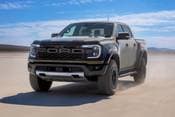2024 Ford Ranger Raptor
Price Range: $55,470
Helpful shopping links
2024 Ford Ranger videos
Toyota Tacoma TRD Pro vs. Ford Ranger Raptor vs. Chevy Colorado ZR2 Bison | Off-Road Comparison Test
The Toyota Tacoma, Ford Ranger, and Chevy Colorado are all recently redesigned — and that means we’ve got brand spankin’ new off-road versions to put to the test, too. In this video, Edmunds’ Emme Hall takes the new Toyota Tacoma TRD Pro, Ford Ranger Raptor, and Chevy Colorado ZR2 Bison to the dirt to find out which midsize off-roader has the superior capabilities.
 Toyota Tacoma TRD Pro vs. Ford Ranger Raptor vs. Chevy Color...
Toyota Tacoma TRD Pro vs. Ford Ranger Raptor vs. Chevy Color... Off-Road Comparison Test: Toyota Tacoma TRD Off-Road vs. For...
Off-Road Comparison Test: Toyota Tacoma TRD Off-Road vs. For... Toyota Tacoma vs. Ford Ranger vs. Chevrolet Colorado: Midsiz...
Toyota Tacoma vs. Ford Ranger vs. Chevrolet Colorado: Midsiz... 2024 Ford Ranger Raptor First Drive | Smaller Truck, Big Off...
2024 Ford Ranger Raptor First Drive | Smaller Truck, Big Off... Future Cars to Get Excited About | The Best New & Upcoming C...
Future Cars to Get Excited About | The Best New & Upcoming C... Midsize Truck Comparison: 2024 Ford Ranger vs. 2023 Chevrole...
Midsize Truck Comparison: 2024 Ford Ranger vs. 2023 Chevrole... All-New 2024 Ford Ranger First Look | The Ranger Raptor Has ...
All-New 2024 Ford Ranger First Look | The Ranger Raptor Has ... These Are the MOST ANTICIPATED Cars of 2023-2024 | The Hotte...
These Are the MOST ANTICIPATED Cars of 2023-2024 | The Hotte...
PRICE CHECKER™
Check a dealer's price
Bring back a dealer's quote, and we'll tell you if it's a good price!
Check your price quote
Price:
$ -
Graph shown is a sample only
FAQ
Is the Ford Ranger a good car?
The Edmunds experts tested the 2024 Ranger both on the road and at the track, giving it a 8.2 out of 10. And then there's safety and reliability. Edmunds has all the latest NHTSA and IIHS crash-test scores, plus industry-leading expert and consumer reviews to help you understand what it's like to own and maintain a Ford Ranger. Learn more
What's new in the 2024 Ford Ranger?
According to Edmunds’ car experts, here’s what’s new for the 2024 Ford Ranger:
- Redesigned for 2024
- Turbocharged engine options all around
- New off-road-focused Ranger Raptor version
- 2024 kicks off the fifth Ranger generation
Is the Ford Ranger reliable?
To determine whether the Ford Ranger is reliable, read Edmunds' authentic consumer reviews, which come from real owners and reveal what it's like to live with the Ranger. Look for specific complaints that keep popping up in the reviews, and be sure to compare the Ranger's average consumer rating to that of competing vehicles. Learn more
Is the 2024 Ford Ranger a good car?
There's a lot to consider if you're wondering whether the 2024 Ford Ranger is a good car. Edmunds' expert testing team reviewed the 2024 Ranger and gave it a 8.2 out of 10. Safety scores, fuel economy, cargo capacity and feature availability should all be factors in determining whether the 2024 Ranger is a good car for you. Learn more
How much should I pay for a 2024 Ford Ranger?
The least-expensive 2024 Ford Ranger is the 2024 Ford Ranger Raptor 4dr Crew Cab 4WD SB (3.0L 6cyl Turbo 10A). Including destination charge, it arrives with a Manufacturer's Suggested Retail Price (MSRP) of about $55,470.
Other versions include:
- Raptor 4dr Crew Cab 4WD SB (3.0L 6cyl Turbo 10A) which starts at $55,470
What are the different models of Ford Ranger?
If you're interested in the Ford Ranger, the next question is, which Ranger model is right for you? Ranger variants include Raptor 4dr Crew Cab 4WD SB (3.0L 6cyl Turbo 10A). For a full list of Ranger models, check out Edmunds’ Features & Specs page. Learn more









